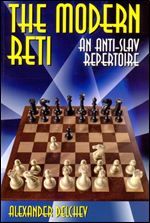Modern Reti, The
An Anti-Slav Repertoire
Alexander Delchev

The first thing to realize about The Modern Reti: An Anti-Slav Repertoire by Alexander Delchev is that it is not a complete single volume opening repertoire book. Those who play 1.Nf3 who are looking for an answer to the Kings Indian, Grunfeld, Dutch, 1 …c5, etc. will be disappointed. However, this book does what the title advertises and more and the reader will find not only anti-Slav weapons (two systems proposed one solid and one sharp) but also a anti-Queens Gambit Declined weapon (a Reti setup with possible Catalan transpositions and reversed Benoni setups) and a simple weapon against the Queens Gambit Accepted. All that is needed to know after 1.Nf3 d5 2.c4 is to be found here.
The subject of Delchevs third book for Chess Stars (the first two were on the Taimanov Sicilian Grunfeld from Blacks perspective) covers the following variations:
● Foreword (2 pages)
● Introduction (4 pages)
● Anti-QGA 1.Nf3 d5 2c4 dxc4 (14 pages)
● Reversed Benoni 1.Nf3 d5 2.c4 d4 (28 pages)
● Anti-Slav and Anti-Chebanenko 1.Nf3 d5 2.c4 c6 3.e3! rate 3rd moves, …Bf5, ...Bg4, …a6 set-ups (30 pages)
● Anti-Meran I 1.Nf3 d5 2.c4 e6 3.e3! Nf6 4.Nc3 e6 (12 pages)
● Anti-Meran II 4.Nc3 e6 5.b3 Nbd7 6.Qc2 Bd6 7.Bb2 with Rg1 (20 pages)
● Anti-Meran III 4.Nc3 e6 5.b3 Nbd7 6.Qc2 Bd6 7.Bb2 0-0 8.Be2 (32 pages)
● Anti-Queen’s Gambit I 1.Nf3 d5 2 .c4 e6 3 .g3 rare systems; 3…dxc4 4.Qa4+ (24 pages)
● Anti-Queen’s Gambit II 1.Nf3 d5 2.c4 e6 3.g3 Nf6 4.Bg2 Be7 5.0-0 0- 0 6.b3 (40 pages)
● Index of Variations (2 pages)
The standard answer to 1.Nf3 d5 2.c4 dxc4 use to be 3.Na3 but Black has several satisfactory answers. What Delchev proposes is interesting but tricky. White plays 3.e3 but after 3…c5 4.Bxc4 Nf6 5.0-0 e6 he does not transpose into a QGA immediately with 6.d4 but instead plays 6.Qe2!. After 6…Nc6 7.Rd1! Be7 8.Nc3 0-0 9.d4 play has transposed into the old-fashioned Steinitz variation of the QGA which favors White. If Black opts for the more and flexible 6…a6 the beauty of white’s setup is revealed: 7.Rd1 b5 8. Bb3 Bb7 9.a4! b4 (9…Qb6 10.axb5 axb5 11.Rxa8 Bxa8 12.Bc2!? Be7 13.Na3 b4 14.Nc4 Qc7 15.b3 and White has the better pieces – Delchev.) 10.d3! Nc6 11.Nbd2 Qc7 12.Nc4 and Whites play is easier, Tomashevsky-Ganguly, Moscow 2007.
Arguably the most important chapter in this book is on 1.Nf3 d5 2.c4 d4. Some might think that this setup, a reversed Benoni if you will, would automatically favor White with his extra tempo. They would be mistaken. The extra tempo often plays no role and moving second in these positions Black often gains flexibility (for example whether to play …c5 or not). Viktor Kortchnoi, playing Yasser Seirawan in a five minute game as Black, reached the position after 1.Nf3 d5 2.c4 d4 and proclaimed, Black is better! Things are not that clear, but it is true that White is having a tough time proving any advantage after 3.e3 or 3.g3. Delchev instead focuses on the more fashionable 3.b4 with the key line 3… f6 4.e3 e5 5.c5 a5 6.Bb5+ c6 7.Bc4, which he analyzes very deeply. This is a very sharp position that poses plenty of danger for Black.
The heart of the book, as advertised, is the Anti-Slav setup that occurs after 1.Nf3 d5 2.c4 c6 3.e3 Nf6 4.Nc3 e6 5.b3, and the next two chapters continue 5 …Nbd7 6.Qc2 Bd6 7.Bb2 0-0. Here Delchev offers two plans for White: the modern and aggressive approach with 8.Rg1 and a quick g4 (chapter 5) and the more restrained 8.Be2 (chapter 6). Which setup to adopt is very much a question of taste.
The follow part of the book focuses on 1.Nf3 d5 2.c4 e6. This time Delchev recommends 3.g3, with the main line in Chapter 8 starting 3 …Nf6 4.Bg2 Be7 5.0-0 0-0 6.b3 (rather than 6.d4, transposing to a Catalan). His idea is to meet any early …dxc4 captures by Black with Qa4+. This approach is innocuous in the Catalan proper but with the pawn not committed to d4 yet White has much more flexibility.
The lines after 6.b3 were favored by Botvinnik near the end of his career and offer White a strong alternative to the Catalan. White often follows with Bb2, e3, Qe2 and b. Depending on how Black counters White can play in the center with d2-d4 (as recommended by Marin in his Quality Chess repertoire based on 1.c4 and 2.g3) or initiate a kingside by advancing his pawns on that wing (the approach normally favored by Delchev).
This is a great book for those who open 1.Nf3 and after 1… d5 want to stay in the style of Reti with 2.c4 (as opposed to 2.g3 or 2.d4). This book will appeal not only to Reti enthusiasts but those who open 1.c4 and who do not want to have enter into the QGA, QGD or Slav/Semi-Slav after …e6 or …c6. The Modern Reti also makes interesting reading for those who reach the Catalan via 1.Nf3 who do not want to have to study all the sharp lines arising after 1.Nf3 Nf6 2.c4 e6 3.g3 d5 4.d4 dxc4. Instead after 1.Nf3 d5 2.c4 e6 3.g3 Nf6 4.Bg2 Be7 5.0-0 0-0 they play 6.d4 and only have to have answers for 6…dxc4 or 6…c6/6…Nbd7.
This book is primarily intended for an audience rated 2000 and above but the division of the material into an explanation of the ideas (Step by Step), theory and complete annotated games makes the material accessible to a wider audience.
Highly Recommended.
